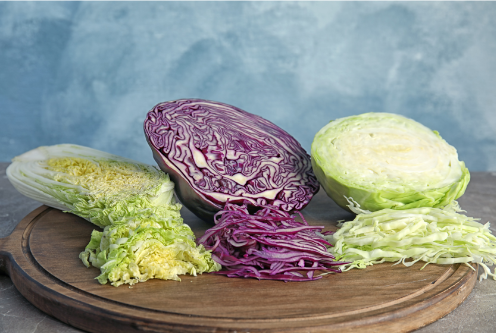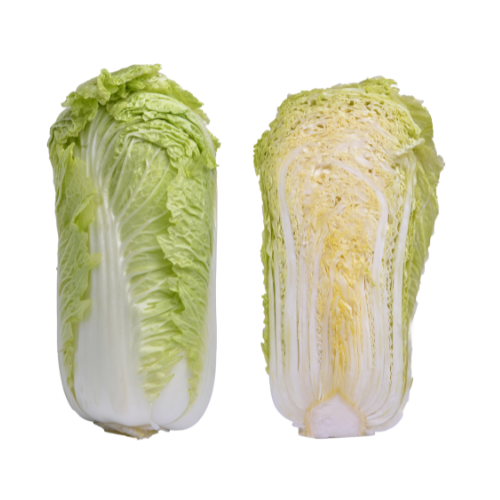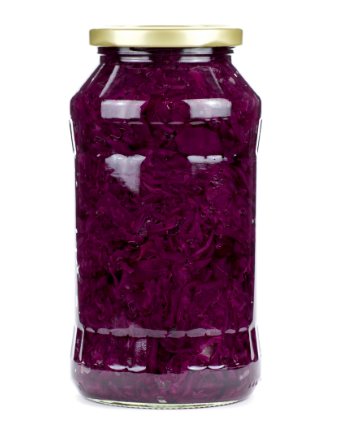Red cabbage (Brassica oleracea var. capitata f. rubra) is a variant of the cabbage plant that is believed to have originated in the Mediterranean region and parts of Europe. It has a long history of cultivation, dating back over 2,500 years.
It is a cool-season crop typically planted in spring or early summer, requiring well-drained, fertile soil and plenty of sunlight. The heads, or cabbages, are ready for harvesting when they reach a firm, compact size, usually 70 to 90 days after planting. They are harvested by cutting the entire head from the plant at the base.
Red cabbage can be preserved and stored through various methods. It can be refrigerated for several weeks, but it’s often pickled or fermented to extend its shelf life. Sauerkraut is a standard preservation method where red cabbage is finely sliced, salted, and fermented in a brine. Sauerkraut can be stored for several months in a cool, dark place.
Types of Cabbages:


There are several varieties of cabbage, including:
- Green Cabbage: The most common type, with a pale green color.
- Savoy Cabbage: A crinkly-leafed cabbage with a mild flavor.
- Napa Cabbage: Also known as Chinese cabbage, it has a more elongated shape.
- Bok Choy: A variety of Chinese cabbage with thick white stalks and dark green leaves.
- Red Cabbage: Known for its deep purple-red color, it is used in various dishes and salads.
- Conehead Cabbage: Resembles a cone shape, like green cabbage, but with a more pointed head.
Red cabbage is consumed in various countries, often in salads, coleslaws, and side dishes. The most common varieties include:

- Germany: Red cabbage is a staple, often prepared as “Rotkohl,” a sweet and sour dish.
- Sweden: It is commonly pickled and used as a side dish.
- United States: Red cabbage is used in coleslaw and salads, adding color and flavor.
- France: Often served as a crunchy and colorful addition to salads.
- Scandinavian countries: Pickled red cabbage is a traditional accompaniment to many dishes.
Red cabbage is highly nutritious, offering an array of vitamins and minerals, including:
- Vitamin C: Essential for the immune system and skin health.
- Vitamin K: Important for blood clotting and bone health.
- Dietary Fiber: Helps with digestion and can promote feelings of fullness.
- Antioxidants: Red cabbage contains anthocyanins, which have antioxidant properties.
- Minerals: It provides minerals like potassium and calcium.
Health Benefits of Eating Red Cabbage
Consuming red cabbage and other cabbages can provide various health benefits, including:
- Antioxidant Protection: The anthocyanins in red cabbage help protect cells from oxidative damage.
- Anti-Inflammatory: It has anti-inflammatory properties due to its phytonutrient content.
- Digestive Health: The dietary fiber in cabbage promotes healthy digestion.
- Heart Health: The potassium content can help regulate blood pressure.
- Weight Management: Low in calories and high in fiber, it can support weight control.
- Bone Health: The vitamin K in red cabbage is essential for bone strength.
Recipe for Braised Cabbage
Equipment needed
Medium Pot with lid, Cutting board, Baker scale, Chef knife, measuring cup
Mise en place
Gather and weigh all ingredients.
Wash and cut vegetables as per recipe.
Preheat oven to 350 degrees F/ 177 degrees C
| Ingredients Quantity |
| Red cabbage head 170 g |
| Apples, peeled, small diced 25 g |
| Cooking Onions 15 g |
| Vegetable oil 15 ml |
| Apple Cider Vinegar 30 ml |
| Water 150 ml |
| Sugar 10 g |
| Salt 1.25 ml |
| Ground Cloves Pinch |
| Black pepper 1.25 ml |
Method
1: Heat the oil in a medium pot over medium-low heat
2: Add the oil and sweat until translucent
3: Add water, vinegar, water, sugar, and a pinch of ground cloves and simmer for 5 minutes
4: Add the cabbage and apples, cover with lid, and braise in a 350 degrees F/177 degrees C oven for 45 minutes to 1 hour until the cabbage is tender.
5: Season to taste with salt and pepper
6: Garnish and serve
NB: Keep peeled apples in lemon water until needed to prevent browning.
Check the cabbage in the oven to ensure all the water is not evaporated. Add a little more water if needed.
